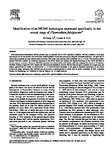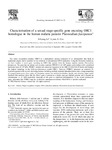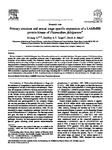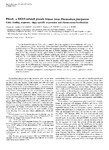Identification of an MCM4 homologue expressed specifically in the sexual stage of Plasmodium falciparum.
| dc.contributor.author | Li, JL | en |
| dc.contributor.author | Cox, LS | en |
| dc.date.accessioned | 2017-11-27T18:36:56Z | |
| dc.date.available | 2017-11-27T18:36:56Z | |
| dc.date.issued | 2001-09 | en |
| dc.identifier.issn | 0020-7519 | en |
| dc.identifier.uri | http://hdl.handle.net/10026.1/10321 | |
| dc.description.abstract |
Mini-chromosome maintenance (MCM) proteins play an essential role in DNA replication initiation. We have isolated a novel gene encoding an MCM-like protein from the human malaria parasite Plasmodium falciparum using the vectorette technique. The gene has no introns and comprises an open reading frame encoding 1005 amino acid residues with a predicted Mr of 115 kDa. The encoded protein, termed PfMCM4, contains all conserved sequences in the MCM family and displays the highest homology to the Cdc54 (MCM4) of Saccharomyces cerevisiae. However, PfMCM4 possesses five unique amino acid inserts with sizes ranging from seven to 75 residues. Southern blotting of genomic DNA digests and chromosomal separations showed that the Pfmcm4 gene is present as a single copy per haploid genome and is located on chromosome 13. A 4000-nucleotide transcript of this gene is expressed specifically in the sexual erythrocytic stage, indicating that PfMCM4 may be involved in gametogenesis in which DNA is quickly replicated. | en |
| dc.format.extent | 1246 - 1252 | en |
| dc.language | eng | en |
| dc.language.iso | eng | en |
| dc.subject | Amino Acid Sequence | en |
| dc.subject | Animals | en |
| dc.subject | Base Sequence | en |
| dc.subject | Cell Cycle Proteins | en |
| dc.subject | DNA-Binding Proteins | en |
| dc.subject | Gene Expression Regulation, Developmental | en |
| dc.subject | Minichromosome Maintenance Complex Component 4 | en |
| dc.subject | Molecular Sequence Data | en |
| dc.subject | Plasmodium falciparum | en |
| dc.subject | Polymerase Chain Reaction | en |
| dc.subject | Restriction Mapping | en |
| dc.subject | Saccharomyces cerevisiae | en |
| dc.subject | Saccharomyces cerevisiae Proteins | en |
| dc.subject | Sequence Alignment | en |
| dc.subject | Sequence Homology, Amino Acid | en |
| dc.title | Identification of an MCM4 homologue expressed specifically in the sexual stage of Plasmodium falciparum. | en |
| dc.type | Journal Article | |
| plymouth.author-url | https://www.ncbi.nlm.nih.gov/pubmed/11513894 | en |
| plymouth.issue | 11 | en |
| plymouth.volume | 31 | en |
| plymouth.publication-status | Published | en |
| plymouth.journal | Int J Parasitol | en |
| dc.identifier.doi | 10.1016/s0020-7519(01)00237-5 | en |
| plymouth.organisational-group | /Plymouth | |
| plymouth.organisational-group | /Plymouth/REF 2021 Researchers by UoA | |
| plymouth.organisational-group | /Plymouth/REF 2021 Researchers by UoA/UoA01 Clinical Medicine | |
| plymouth.organisational-group | /Plymouth/REF 2021 Researchers by UoA/UoA01 Clinical Medicine/UoA01 Clinical Medicine | |
| dc.publisher.place | England | en |
| dc.rights.embargoperiod | Not known | en |
| rioxxterms.versionofrecord | 10.1016/s0020-7519(01)00237-5 | en |
| rioxxterms.licenseref.uri | http://www.rioxx.net/licenses/all-rights-reserved | en |
| rioxxterms.type | Journal Article/Review | en |





